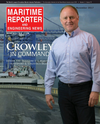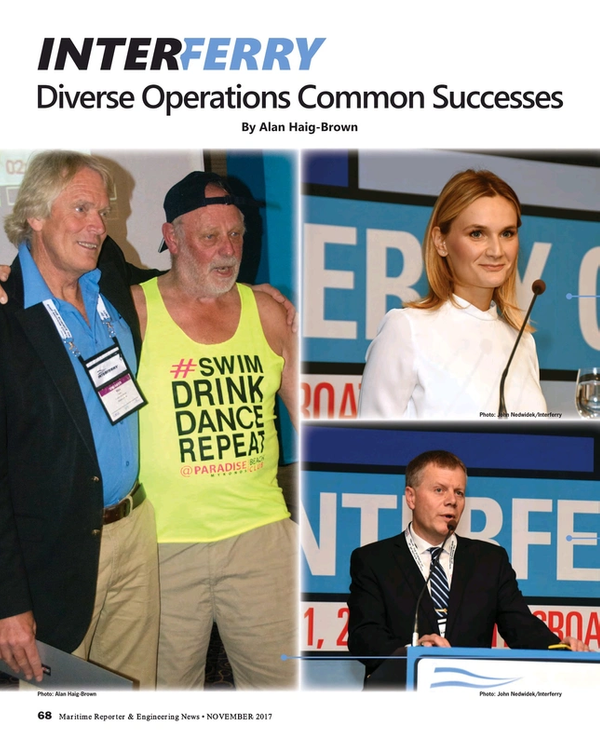
Interferry: Diverse Operations Common Successes
By Alan Haig-Brown
In October the world’s ferry operators gathered in Split Croatia for the Forty Second Annual Interferry Conference. The 470 or so delegates represented 210 operators and support companies from 27 countries. A trade show included firms from around the world including shipbuilders, naval architects, equipment suppliers, training and others of the diverse group that make up the ferry industry.
In a panel on Mediterranean Ferries, Philippe Holthof, of the Belgian-based Shipax explained the huge size and complexity of the fleet. While RoRo ferries are important in trans-med service, Italy has also taken the initiative in getting trucks off the highways in favor of RoRo services running up and down their coast. To support competition among ferry operators, subsidies go to the truckers rather than the ferries. He also pointed out that the old “rust bucket” fleet is now gone in favor of modern vessels, although LNG as a fuel has not been adopted largely due to the challenges of cooling the fuel with Mediterranean waters having temperatures in the 28 degree range.
In keeping with a time when world leaders rule by Twitter, there was appropriate coverage of the role of big data mining, utilizing social media for customer contact and the challenges of providing unlimited connectivity for passengers. In terms of bandwidth, Ole Sivertsen of USA-based Global Eagle explained that passengers are no longer just surf the net, but they are up loading vacation photos putting ever-greater demand on the marine systems. Meanwhile, Mark Collins of the British Columbia Ferries explained the challenges of passengers expecting free and seamless WiFi on routes that are often out of range of towers and must rely on expensive satellite services for connectivity.
In another example of the digitized ferry world, Dr. Roberta Weisbrod, Executive Director of the US-based Worldwide Ferry Safety Association, told of a New York ferry company whose navigators were using Google glasses. The glasses have navigational info that allows the vessel navigator to keep focused outside the bridge windows or even to walk around on the bridge wing while still tracking their vessel. She pointed out the obvious danger of system hacking and problems should the system go down while the continued loss of traditional navigation skill-sets remains a concern.
Ferry safety continued as a theme with John Wright of Wrightway, a UK-based consulting firm that has recently worked with BC Ferries in Canada. He stressed that safety had to be “top down and bottom up” with capturing the hearts and minds of middle management the key to including all in the ownership of a program. Markku Mylly of the Portugal-based European Maritime Safety Agency (EMSA) followed up on safety concerns for the modern ferry industry. He explained that the EMSA is the EU equivalent of the IMO. Along with other presenters he raised the concern of fires on RoRo ferries. These nearly always start on vehicles, both cars and cargo trucks, stowed on the cargo decks. His organization is currently conducting an extensive investigation into the problem and will submit their findings to the IMO.
The electric option for powering ferries was given a good airing in a panel with representatives from CalMak Ferries in the UK, ABB Finland, PBES Canada and Colorline, Norway. While there was agreement that electric had the potential for a zero emission ferry, there are generally some emissions from the onshore generation of electric power. The continuing efficiency of battery technology bodes well for the future with, one contributor maintaining that, fully 70% of new vessel proposals now include some option for electric storage.
Jan Helge Pile, of Norway’s Colorline, told of his firm’s designing of a new 160-meter, 2000-passenger, Ro-Pax ferry with about a 500-car capacity for a route between Norway and Sweden. In 2012, they had originally anticipated LNG for power. However when they ran a competition for the lowest emissions overall, it was an electric hybrid system that won. The winning proposal for a mono-hull ferry, currently under construction at the Ulstein yard for 2019 delivery, will use pure electric power in the port and fjord areas. This will make 20% of the 38 nautical mile route at zero emission. It will charge the batteries via plug-in at ports and generators at sea, making it the world’s largest plug-in hybrid. At the same time, emissions will be dramatically reduced, especially in the sensitive fjord and port areas.
The attendees were delighted with the good-humored sparring of two Australian heavy weights of the ferry world: Austal’s Mike Wake and Incat’s Bob Clifford. Clifford, an icon of the industry and dressed in casual Aussie attire, made the case for the efficiency of “two long skinny hulls” while Wake, with an impressive video, argued for the sea kindliness of a third central hull. While there was no agreement on the best hull form, both speakers agreed that the future of fast ferries is secure as they continue to become more efficient with weight reduction and fine-tuning of designs.
Earlier in the conference, in a panel on the demographics of ferry passengers and crew, Marija Zaputavic of the host Jadrolinija Ferries of Croatia talked of her company. She explained that their many ferries serve the islands of the Adriatic. Periodically the company does surveys of their passengers’ wants and needs. But they must balance the wishes of the large number of tourists with the needs of the year round island residents. This is a challenge that operators around the world would do well to acknowledge.
On the same panel, Capt. Morgan Mooney of New York’s Fire Island Ferries spoke to the need to attract and retain young crew such as her. With 14 years in the family company, seven as captain, she spoke to the need to acknowledge, listen to and reward the millennials who will make up the next generation of mariners. “Look to the teenage deck hands. Don’t belittle them but let them know that they have a future with the company. Help pay for them to upgrade their tickets,” she said, before adding with a smile, “I am turning 30 and I plan to keep working for you, Dad.”
As representatives of the host nation, the Croatian national carrier Jadrolinija Ferries, invited attendees to a technical visit onboard their Split to the Island of Brac ferry run. Jadrolinija has 50 ships serving 40 islands in the Adriatic Sea as well as operating on four international routes. Conference guests were welcomed aboard the ferry Hrvat and then taken in small groups to visit the bridge and the engine rooms. The later are located fore and aft with two propulsion engines in each engine room. These drive azimuthing z-drives located in each of the vessel’s four corners to give the ferry both good speed and remarkable maneuverability.
It was a fitting wrap up for a conference that celebrated and shared ideas amongst diverse ferry operators who share concerns and successes in wide-ranging conditions and populations. In a now traditional ceremony, Alan Klanac of Inteferry Croatia, passed the Interferry flag on to, Germán Orozco of Ultramar, Mexico with the announcement that Interferry 43 will be held on October 6 to 10, 2018 in Cancun, Mexico.
(As published in the November 2017 edition of Maritime Reporter & Engineering News)
Read Interferry: Diverse Operations Common Successes in Pdf, Flash or Html5 edition of November 2017 Maritime Reporter
Other stories from November 2017 issue
Content
- The Challenge of Marine Asset Appraisal page: 12
- US Navy: Back to Basics page: 16
- The Best Options for Safe Mooring page: 18
- Deck Machinery: Five Stress Areas page: 20
- Five Requirements for Safe Ops page: 22
- How Augmented Reality Technology Could Transform Shipping page: 26
- Eye on Design: C-DRONE page: 28
- IMO Orders Fuels of the Future page: 30
- Voices: Howard Fireman, SVP & CTO, ABS page: 32
- Inside the World's First LNG Containership Conversion page: 36
- Voices: Paul Smulders, CEO, Radio Holland page: 42
- Voices: Rich Merhige, President/Owner, AME page: 44
- A New Breed of Tug page: 54
- Wind Energy Workboats: A US Offshore Build-up page: 60
- Bouchard Set to Celebrate a Century page: 66
- Strategic Marine: Innovative Quality page: 67
- Interferry: Diverse Operations Common Successes page: 68
- Voices: Paulo Cesar P. Freitas, Norsul page: 72
- Managing the New Panamax Containerships page: 80
- Coatings & Corrosion Control Take Center Stage page: 84
- W&O Supply Holds a Steady Course page: 90


